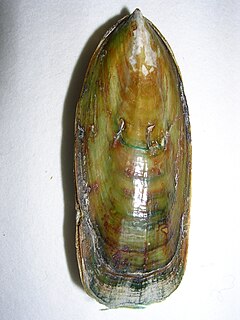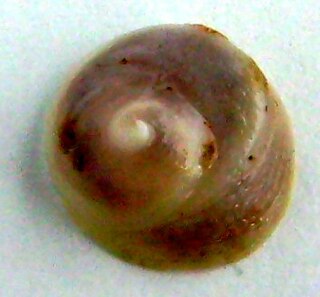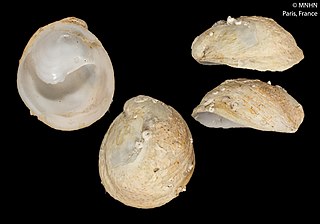
Fauna is all of the animal life present in a particular region or time. The corresponding term for plants is flora. Flora, fauna and other forms of life such as fungi are collectively referred to as biota. Zoologists and paleontologists use fauna to refer to a typical collection of animals found in a specific time or place, e.g. the "Sonoran Desert fauna" or the "Burgess Shale fauna". Paleontologists sometimes refer to a sequence of faunal stages, which is a series of rocks all containing similar fossils. The study of animals of a particular region is called faunistics.

Lingulata is a class of brachiopods, among the oldest of all brachiopods having existed since the Cambrian period. They are also among the most morphologically conservative of the brachiopods, having lasted from their earliest appearance to the present with very little change in shape. Shells of living specimens found today in the waters around Japan are almost identical to ancient Cambrian fossils.

Nepenthes izumiae is a tropical pitcher plant endemic to Sumatra, where it grows in montane forest at 1700–1900 m above sea level. It appears to be most closely related to N. lingulata and N. singalana.

Nepenthes jamban is a tropical pitcher plant endemic to northern Sumatra. The specific epithet jamban is the Indonesian word for "toilet" and refers to the shape of the pitchers.

Nepenthes lingulata is a tropical pitcher plant endemic to northern Sumatra. The species is characterised by the highly developed appendage present on the underside of the lid. The specific epithet lingulata is derived from the Latin word lingula, meaning "small tongue", and refers to this unique morphological feature.

Guzmania lingulata, the droophead tufted airplant or scarlet star, is a species of flowering plant in the family Bromeliaceae, subfamily Tillandsioideae, native to rainforest habitats in Central America, northern and central South America, southern Mexico and the West Indies. It is an evergreen epiphytic perennial. The Latin word lingulata means "tongue-shaped". Foliage grows in a star-shaped basal rosette which culminates in an orange and red bracted inflorescence. It is among the most commonly cultivated bromeliad types, with cultivars producing flowers in shades of maroon, red, orange, yellow or pink.

Lingula is a genus of brachiopods within the class Lingulata. Lingula or forms very close in appearance have existed possibly since the Cambrian. Like its relatives, it has two unadorned organo-phosphatic valves and a long fleshy stalk. Lingula lives in burrows in barren sandy coastal seafloor and feeds by filtering detritus from the water. It can be detected by a short row of three openings through which it takes in water (sides) and expels it again (middle).

The Calyptraeidae are a family of small to medium-sized marine prosobranch gastropods.
Clarkia lingulata is a rare species of wildflower known by the common name Merced clarkia. This plant is endemic to Mariposa County, California, where it is known from only two sites near the Merced River.
Tayloria lingulata, commonly known as lingulate dung moss, tongue-leaved gland-moss, or marsh collar-moss, is a moss found in montane habitats in the Northern Hemisphere including Europe, Asia and North America.

Crepidula, commonly known as the slipper snails, slipper limpets, or slipper shells, is a genus of sea snails, marine gastropod mollusks in the family Calyptraeidae. This family includes the slipper snails (Crepidula), hat snails (Calyptraea), spiny slipper snails (Bostrycapulus), and cup-and-saucer snails (Crucibulum) as well as Crepipatella, Siphopatella, Grandicrepidula, and Maoricrypta.

Bostrycapulus, commonly known as the spiny slipper snails, is a genus of sea snails, marine gastropod mollusks in the family Calyptraeidae, the slipper snails, cup-and-saucer snails and hat snails.
Rhombodera lingulata is a species of praying mantises in the family Mantidae, found in Asia.

Crepipatella is a genus of sea snails, marine gastropod mollusks in the family Calyptraeidae, the slipper snails and cup-and-saucer snails.

Aechmea lingulata is a plant species in the genus Aechmea. This species is native to the West Indies, Costa Rica, Panama and northern South America.

Crepipatella dilatata is a species of sea snail described by Lamarck. It is a marine gastropod mollusk in the family Calyptraeidae, the slipper snails or slipper limpets, cup-and-saucer snails, and hat snails.

Calyptraea, commonly known as the Chinese hat snails is a genus of sea snails, marine gastropod mollusks in the family Calyptraeidae, a family which contains the slipper snails or slipper limpets, cup-and-saucer snails, and Chinese hat snails.

Hyacinthoides lingulata is a species of bulbous plant that lives in North Africa, from Morocco to Tunisia. It is widespread in short grass and agricultural fields, flowering in autumn when the rains begin. The flowers are generally paler than the common bluebell, but have a similar scent. Its leaves are not fully hardy, and it is usually grown under glass in the British Isles, where it requires a dry rest in summer and watering from early September until it dies back in May.

Frank Harlan Lewis, known professionally as Harlan Lewis, was an American botanist, geneticist, taxonomist, systematist, and evolutionist who worked primarily with plants in the genus Clarkia. He is best known for his theories of "catastrophic selection" and "saltational speciation", which are closely aligned with the concepts of quantum evolution and sympatric speciation. The concepts were first articulated in 1958 by Lewis and Peter H. Raven, and later refined in a 1962 paper by Lewis in which he coined the term "catastrophic selection". In 1966, he referred to the same mechanism as "saltational speciation".

Bransonella is an extinct genus of marine Xenacanth shark which lived during the Paleozoic era. It is known only from teeth which are easily distinguished from related genera by ornamentation on the cusp shaped like an inverted "V" and fin spines Teeth attributed to this genus are small, no greater than 2 millimeters. This suggests a small body size likely not exceeding a meter in length. It has been suggested their lifestyle was similar to modern Catsharks. It was used to erect a new order along with Barbclabornia based on ornamentation.
















